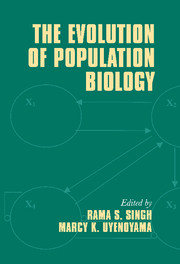Book contents
- Frontmatter
- Contents
- List of contributors
- Publications of R. C. Lewontin
- Preface
- Introduction
- Part I Historical foundations and perspectives
- Part II Genotypes to phenotypes: new genetic and bioinformatic advances
- Part III Phenotypes to fitness: genetics and ecology of populations
- 7 Density-dependent selection
- 8 Nonsynonymous polymorphisms and frequency-dependent selection
- 9 Why k = 4Nus is silly
- 10 Inferences about the structure and history of populations: coalescents and intraspecific phylogeography
- 11 The population genetics of life-history evolution
- 12 Gene–environment complexities: what is interesting to measure and to model?
- 13 Genus–specific diversification of mating types
- Part IV Genes, organisms, and environment: evolutionary case studies
- Part V Applied population biology: biodiversity and food, disease, and health
- Index
8 - Nonsynonymous polymorphisms and frequency-dependent selection
Published online by Cambridge University Press: 08 January 2010
- Frontmatter
- Contents
- List of contributors
- Publications of R. C. Lewontin
- Preface
- Introduction
- Part I Historical foundations and perspectives
- Part II Genotypes to phenotypes: new genetic and bioinformatic advances
- Part III Phenotypes to fitness: genetics and ecology of populations
- 7 Density-dependent selection
- 8 Nonsynonymous polymorphisms and frequency-dependent selection
- 9 Why k = 4Nus is silly
- 10 Inferences about the structure and history of populations: coalescents and intraspecific phylogeography
- 11 The population genetics of life-history evolution
- 12 Gene–environment complexities: what is interesting to measure and to model?
- 13 Genus–specific diversification of mating types
- Part IV Genes, organisms, and environment: evolutionary case studies
- Part V Applied population biology: biodiversity and food, disease, and health
- Index
Summary
Introduction
In discussions about the causes of biological diversity, viewpoints have often been grouped into ‘isms’ (neutralism, selectionism, gradualism, punctuationism), and debated as if they were coherent warring parties. This kind of usage seems more political than scientific. Fortunately, the current group of ‘isms’ is disappearing. Experiments prove hypotheses wrong, however passionately their proponents believe in them. The latest approximations to the truth do not often emerge as victories, or even as compromises, but rather as mosaics of old and new.
Vestiges of the ‘isms’ still remain. For example, it has been customary either to argue that evolutionary replacements and polymorphisms are both predominantly driven by selection or that both are predominantly neutral. Yet, as first pointed out by Fisher (1930), most replacements could be driven by selection even if most polymorphisms were neutral (because selected replacements would contribute little to the standing variation). It is worth considering Fisher's argument, which did not allow for many polymorphisms maintained by selection, to see whether it is compatible with current data.
The debates between “neutralists” and “selectionists” were initially about amino acid replacements in evolution. Here it has transpired that the selectionist view was nearer the truth.
- Type
- Chapter
- Information
- The Evolution of Population Biology , pp. 156 - 177Publisher: Cambridge University PressPrint publication year: 2004
- 2
- Cited by

